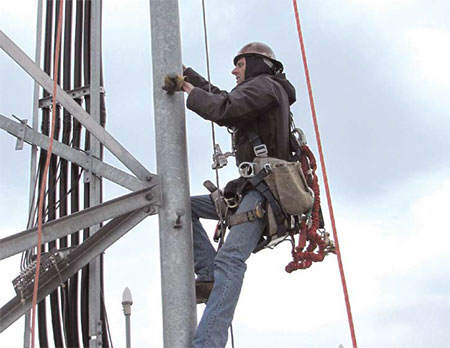Auction and Repack: Doing the Math
Well, in what I can only say is stunning, the second stage of the spectrum auction concluded immediately following the end of the first round of bidding in the forward auction portion. You may have noted that the broadcasters' ask dropped from $88.4 billion to $54.6 billion. What was interesting is that after round one of the second stage forward auction, the wireless offers went from $23.1 billion to $21.5 billion. At the time of this writing the reverse portion of the third stage is just underway with a clearing target of 108 MHz.
I did some crude math for some non-technical colleagues at the end of the first stage of the auction utilizing the raw clearing target and came up with broadcasters asking for about $701.5 million/MHz and the wireless carriers offering about $183.4 million/MHz. I know there are better ways to actually calculate the value of the spectrum but I wanted something easily explainable, kind of like the way mining ore value is estimated per ton. Expanding on my math, I note that even though the wireless providers’ total offer was lower than their previous offer, the reduction in the amount of spectrum being offered actually increased the wireless offer to about $188.6 million per megahertz. But that is a fairly insignificant increase and still way below the broadcasters' ask of approximately $478.8 million/MHz.
BEACHFRONT PROPERTY
On the reverse auction side what I find interesting is how relatively unchanged the cost per MHz offer is despite the increased scarcity of the spectrum available based on the reduction in the clearing target. Less “beachfront property” (as the UHF band has been called), should force a higher price per unit available and while the price per unit did rise slightly, it doesn't appear to be commensurate with the change in the clearing target. The amount of beach front available was reduced by about 10 percent but the marketplace price offer only rose by a little less than 3 percent. It looks like the wireless industry is or has already established a price and that is possibly in the $200 million/MHzrange, maybe a little less or maybe a little more.

I thought about extrapolating the numbers out between the reverse and forward portions to see where they would cross but I doubt that the data would be meaningful. At this point in time there are only two data points to use for extrapolation and estimating the deviation between the stage 2 and stage 3 numbers for the reverse portion is problematic. It is interesting to note however that in the Public Notice DA 16-1095, the FCC used 114 MHz and 84 MHz for their phased clearing scenarios. Since the 114 MHz clearing target stage ended after just one round in the forward section, 84 MHz may be where the FCC thinks it will ultimately end up as the final target. There are certainly clearing targets below 84 MHz but they may not provide enough national coverage to make it worthwhile for the wireless industry.
If I am correct about the $200 million/MHz wireless price, that would put the proceeds from the auction at just about $17 billion which is still quite a stretch when you look at the current broadcasters offer. As I said above, this math is crude and was designed for having a conversation with some non-technical colleagues and was designed to provide just an indication that there is a significant gap between how each side is valuing the spectrum in question and that there is a lot more work to do to make the auction work.
IEEE BTS SYMPOSIUM
Get the TV Tech Newsletter
The professional video industry's #1 source for news, trends and product and tech information. Sign up below.
Enough about the auction, let’s talk about the repack. At the IEEE BTS Annual Broadcast Symposium in Hartford, Conn., Oct. 12-14, I attended a DTV Spectrum Repack presentation by Joe Davis from Chesapeake RF Consultants that was very intriguing. The Symposium took place between the end of the reverse portion and start of the forward portion of stage two, so while there were a lot of unanswerable questions, one point that intrigued me was why did the broadcasters' ask in the reverse auction drop by such a large amount. Did that many broadcasters actually drop their prices? Listening to Joe’s presentation as well as a few others, I am of the opinion that there may have been some small reduction from some of the participating stations but I suspect the lion's share of the reduction was from the FCC making a few key assumptions. The spectrum target reduction and the economic indicators from stage one and the reverse portion of stage two probably have allowed the FCC to estimate what an achievable clearing target will end up being.

Using that knowledge they could make some strategic assumptions. For example, the spectrum from many stations in the uncrowded areas (such as Iowa) will not be needed so they could have been removed from the pool and their asking amounts removed from the total. My opinion has been that it is highly unlikely that many stations in small to medium markets will get any significant revenue unless their spectrum is needed for a nearby large market. With this reduction in the clearing target, the spectrum from these stations may become available through repacking rather than payment.
Another factor that may be coming into play is the relocation from UHF to VHF that some stations may have offered. This could easily be viewed as “low hanging fruit” as it reduces the amount that a station needs to receive to make the move and the costs are borne by the station rather than the repack funds. This concept should give all stations in the VHF band some pause. I know many VHF stations are not giving a lot of thought to repack scenarios but if a significant number of stations move into the VHF bands, disregarding repack simply based on the idea that this is a UHF only issue may lead to some unpleasant surprises.
MOVING TO LOW VHF
One other point raised by my friend Dennis Wallace of Meintel, Sgrignoli and Wallace, had to do with the concept of stations moving to low VHF. Dennis noted that there hasn’t been much equipment production in low VHF for some time so a station looking for a transmitter in that band will find it extremely challenging. I visited the GatesAir website that shows only VHF Band 3 (174 to 240 MHz) products. Similarly, the Comark and Rohde and Schwarz websites also show only VHF Band 3 products. A move to low VHF may require the use of used equipment or getting something custom built. Both of these alternatives have sustainability concerns over time.
Long story short, if you are in the VHF band—whether you are participating in the auction or not—you need to have a repack plan. I also note that many VHF stations are among the oldest facilities, which may mean older towers, so even minor changes can have a huge impact. As a hypothetical example, IPTV’s station in Des Moines, Iowa, is on an Ideco Dresser tower that dates from the mid 1960’s and shares an antenna with another high-band VHF station. There is also a low VHF station on the tower as well as an FM. A repack to any one of the three TV stations would probably necessitate a new tower.
So, regardless of whether or not a station is participating in the auction process, every single station regardless of channel needs to have a repack plan. Regardless of where the new UHF core ends, whether a station is in the new core or not, repacking will happen. Using the estimate from the aforementioned PN, if the clearing target ends up being 84 MHz, then approximately 1,300 stations will need to move to new channels. There are probably about 400 or so television stations operating above channel 36 so about 900 of the stations that need to move will be in the core. It would seem to me then that planning for a repack is not an option but a necessity.
Bill Hayes is director of engineering for Iowa Public Television. He may be reached via TV Technology.
Bill Hayes is the former director of engineering and technology for Iowa PBS and has been at the forefront of broadcast TV technology for more than 40 years. He’s a former president of IEEE’s Broadcast Technology Society, is a Partnership Board Member of the International Broadcasting Convention (IBC) and has contributed extensively to SMPTE and ATSC. He is a recipient of Future's 2021 Tech Leadership Award and SMPTE Fellow.

